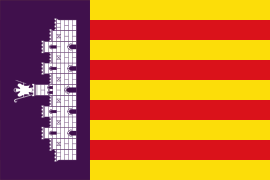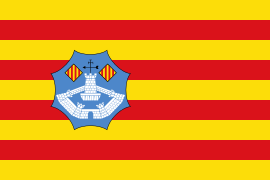Flag of the Balearic Islands
The flag of the Balearic Islands is the flag of the Spanish autonomous community of the Balearic Islands, made official in the Statute of 1983. It is based on the traditional señera, origin of the flag of the ancient kingdom of Mallorca.
Legislation and design
The official status of the flag is included in the Statute of Autonomy of the Balearic Islands approved in 1983 by Organic Law 2/1983 and reformed by Organic Laws 9/1994 and 3/1999, although without altering the articles that defined the community flag:
Article 4 1. The flag of the Balearic Islands, composed of distinctive symbols historically legitimized, will consist of four horizontal red bars on a yellow background, with a barracks located at the top left of a purple background and with a white castle of five towers in the middle. 2. Each island may have its own flag and distinctive symbols, according to the respective island council.
The last Statute of Autonomy, from 2007, maintained the same wording of the article to define the flag, although this became the 6th article.
The autonomous government does not specify specific dyes for the colors of the flag, so the shades of yellow, red and purple usually vary, although the latter is usually shown in a dark tone. Likewise, the design of the castle is not defined, so some with slight differences from each other prevail, such as its size compared to the barracks or the details of its masonry. The castle is generally represented as a wall on which the five towers are superimposed, of which the central tower is usually the tallest.
The Draft Statute of Autonomy of the Balearic Islands of 1931, formulated during the years of the Second Spanish Republic, although not finally approved, only established in its 3rd article that: The flag of the region is that of the ancient Kingdom of Mallorca. However, the old flag of the kingdom of Mallorca was that of the city of Palma, with two castles on a blue background. The current official flags of the Balearic Islands and Mallorca are modern creations based on the aforementioned flag of Palma and do not follow the rules of heraldry (use of purple and rotated castle in the case of Mallorca).
History

Little is known about the flags of the islands during their Taifal era. Ancient sources that describe the conquest of the later kingdom recount a red and white split banner on the Muslim battle side. The conquest of Mallorca by King James I in 1229 and the texts that recounted the feat support several signs (shields or banners) of those who appropriated the island: the king himself, with his usual red bars on yellow, as well such as the Pisan and Genoese contingents and possibly other religious and noble banners. It is also said that the papal authorization of the conquest imposed a red flag over the complex.

The so-called Book of Knowledge dates back to the 1380s, reporting on a banner that shows alternating green and black canes, even though it had been approximately one hundred and fifty years since the island territory had passed into form part of the Crown of Aragon. The confusion is likely due to a misidentification of the flag's original colors. The author drew and described the ensign:
Sallí d'esta Brischan and I went to the island of Majorcas where it is a noble cibdat and rich, and abondadada. King d'ella for signs of green canes and prietos.

The immediate consequence of the conquest of the island, and later, of the rest of the archipelago, was the establishment of peninsular institutions, especially Catalan ones, and the definition of the new territory as a kingdom, thus adopting the banner of the king, James I. the Conqueror. The number of bars in the sign (or sticks in the shields) still remains variable.
Jaime I's granting of the first seal to the Juries of the City and Kingdom dates back to 1269:
"convinent thing sia and acordable to rahó quascuna Ciutat segel propri de comunitat aver. A segell that dela una part sia lo senyal nostre e en l'altre part lo senyal del Castel nostre dela Almudayna de Malorques»
That is, the seal had to be formed with the arms of the king of Aragon, on one side and on the other the representation of the Almudaina castle (Royal Palace of Almudaina) splashed by the waves of the sea.
Later, in 1312, King Sancho I of Mallorca, second exclusive king of Mallorca, granted a banner that was surely the same or similar to the previous one, through a text that provided more details:
"Sancho, by the grace of God king of Majorca, count of the Rossellón. To his faithful Jury of Mallorca. Your ambassadors have appeared before our presence and asked us to tell us to grant to the University, City and Kingdom of Mallorca a teaching to hold it in the pendoms and other flags. We grant a lesson, this is that at the bottom has our actual soft of the sticks. signum nostrum royale bastonatumand on top the figure of the white castle on purple signum castri albi positi in lividowhich your ambassadors made to paint on paper and convey to you: wanting and establishing that such is your teaching and that of the whole Kingdom of Majorca. Given in Montpeller 19 days before the January Kalendas of the year of the Lord 1312»
At the beginning of the 20th century, the color livido led to discussion about the definition of what color the document referred to. Some scholars of the time considered that it was purple - the origin of the color of the current flag - although, due to heraldic tradition and the signs of the sign on carved or painted shields, they favor the interpretation of that color as blue (azur).
This flag was widely used to identify the kingdom's ships, to differentiate themselves from Catalan ships. After the kingdom was reintegrated into the Crown of Aragon (definitive invasion by Peter IV of Aragon in 1343), it is very likely that the use of the flag decreased, although it continued to be reproduced on maps and portulans.
When in 1907 the Palma City Council wanted to recover the flag of Mallorca, it did so based on the description in the Royal Charter of King Sancho I, although, instead of placing the three masts of the House of Mallorca, it placed the four suits of the kings of Aragon.
Island flags
Flag of Ibiza
Flag of Formentera
Flag of Mallorca
Flag of Menorca





